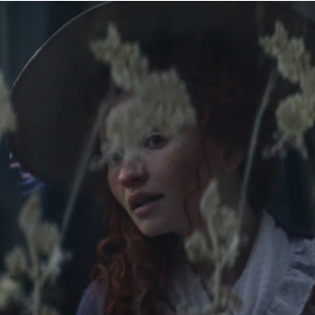 by Maria Melnik
by Maria Melnik Illustrator: Adam Kane
on 11th June 2017
Genres: Adult, Fantasy, Paranormal Fantasy, Urban Fantasy

Laura and Sweeney continue their trip to Kentucky in search of somebody with the power to bring Mrs. Moon back to life.
At the same time, the leprechaun's past is detailed through the lens of his lifelong relationship with seventeenth-century Irish immigrant Essie MacGowan, whose journey to America was a complicated one.
*
In perhaps the vaguest of terms, I’ve been expecting this episode for a few weeks now. Once the writers made it clear that they were willing to devote an entire hour to exploring some of American Gods’ secondary characters (in addition to punching up their importance to the main storyline), I had the feeling that Mad Sweeney would be on the list for the treatment. And so, ever since “Git Gone” gave us more Laura, I knew that we would eventually get an ode to the leprechaun in our cast.
That’s sort of what “A Prayer for Mad Sweeney” is, I guess. It’s definitely another round of backstory; it just doesn’t present it in the way that I expected it to.

Rather than being entirely focused on everybody’s favorite man of the hills, the penultimate episode of our freshman season is a rather fluid mishmash of a ‘Coming to America’ tale and a continuation of one of the modern-day subplots. Sweeney is certainly involved in all of these things, but he isn’t really the centerpiece; no character really is, in fact. Looking back at it, actually, I’m not really sure what this week’s real purpose is.
I’m not saying that it isn’t a good episode, by any means. It just doesn’t feel like the kind of script that you would use to lead into your show’s first big finale — which, judging by the preview, is going to be bonkers. “Prayer” doesn’t seem to do much setup for things to come, but neither does it strike me as a frivolous or unimportant episode.
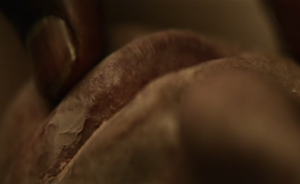
In the end, I guess, it’s mostly a gentle nudge to get everything in place. It doesn’t pose any dramatic cliffhangers or questions to see us through to the year’s climax, but it nicely fills out the remaining pieces that we’re (probably) going to need when everything comes to a head.
Episode seven is something of an experiment as a result, but I think that it works. Shadow and Wednesday are completely absent — they don’t even get minor cameos, like they have in the past — and the larger arc of the gods’ war is firmly left in the backseat, so the fact that this week still manages to be as enjoyable and engaging as it is gives testament to the show’s strengths. It also proves that the series is capable of doing exactly what I was hoping it would: expand its source material’s world and cast into something more complex and ensemble-driven without losing sight of the important stuff.
To the episode!
Spoiler Warning
Below are spoilers for both the episode and the book, so continue at your own risk. Going forward, I’ll try to avoid too many mentions of later events, so as long as you’ve watched, you should be okay. Hopefully. No hard-and-fast promises, though.
*
Present Day
What’s interesting about this week is how, like “Git Gone,” it takes place largely in flashback. Unlike that episode, though, it isn’t entirely new material. Rather, the writers decided to take one of these prequel stories and use it as the framing device for the entire episode, rather than just as a few-minute lead-in to the remaining running time.

The book told the tale of Essie Tregowan (changed here to Essie MacGowan, for some reason) right before Shadow and Wednesday’s bank heist, and wasn’t any longer than the other ‘Coming to America’ shorts. I was sort of bummed when they skipped it earlier in the season, but I’m glad to see it brought back — albeit flushed out and expanded in a pretty notable way. Again, a surprising direction, but it has its payoffs.
Ibis and Jackal spend their evening at their funeral parlor. The former wants to drink, the latter doesn’t have the time as he works to prepare a body for presentation. He explains that he needs to get the man done, because they will have two more coming in the morning. Ibis points out that they haven’t gotten a call about anybody yet, but Jackal assures him that it will come within an hour.

Ibis asks if he wants help, but Jackal waves him off, claiming that he has another story to tell. Ibis isn’t sure about that, but his partner says he can see it “in his fingers.” In his office, Ibis looks at a map of a plantation in old America. He then pulls out his book and begins to write.
I like how they’re using these bits to spend more time with these two. There’s a clever detail here that I never thought about: given Anubis’s other line of work, it would make sense for him to use his knowledge of death in his day job. It also calls into question how Ibis’s stories work. Do they just come to him in visions? If they do, is there some rhyme or reason to them? Does he have to write them down? What happens if he doesn’t? Does he intend to use them for anything?
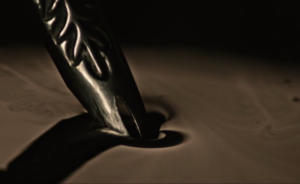
Anyway, point of note: Ibis narrates most of the rest of the episode from here on out, and most of said narration is straight from the book. It’s a pretty faithful adaptation of the story, with a few additional details thrown in to stretch it out.
Ibis opens with the note that the concept of America being an open, empty space that was filled with new people is a fiction — it was more a “dumping ground” where people could rid themselves of memories and pasts. (There’s also the fact that people, you know, already lived there. And then we took the land from them. But, hey, we’ll gloss over that tidbit.)
The phone rings and Jackal answers. Sure enough, it’s news that two women have died.

This week comes to you from the inside of a phone, I guess.
*
Coming to America
1721
Ibis describes how, back in the early days, one could be hanged for the smallest offences. As a result, many would jump on the alternative: travel to America, work under a master as an indentured servant to pay off their debt, then start a new life there.
In a field, Mad Sweeney walks up and asks for Essie MacGowan. Ibis pauses. Then he starts at the beginning.
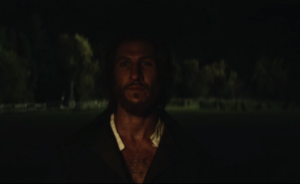
He begins with her childhood: Essie was a free-spirited child in a small seaside town in Cornwall (I assume — that’s where the book placed her, but the show never really specifies). She tended to avoid responsibility and listened to the tales her grandmother (Fionnula Flanagan) told of faeries and púcas, banshees and spirits. Her father was often away at sea, so the two kept one another company as they waited for him to return.
Her grandmother spoke of leprechauns, who have no time for anything but their gold. Essie wants to know why, then, she needs to give them gifts, and learns that such offerings are necessary if one want their blessings. The men of the hill are temperamental folk, after all.


Essie reaches adulthood, and is one of the few in her hometown to keep the practices alive, leaving milk for the creatures at the window every night.
She’s also being played, rather confusingly, by Emily Browning.

Huh.
Let’s talk about this, shall we?
I get what they were going for here, because Laura and Sweeney’s storyline is the other main plot of this week, and I think the writers wanted to draw parallels between the two women’s lives. It’s a good idea in theory, but it doesn’t entirely work for me for two reasons:
First, I’m not sure the pair are similar enough to justify the comparisons. On the surface, it seems that they might have some notable things in common, but said characteristics are quite different when you contextualize them, so having one actress play two roles comes across as a rather gimmicky approach meant to force correlations that aren’t really there.
Second, it robs Essie of her independence. Her autonomy is the entire point of her character arc here, but having Browning in the role steals that away. Because she only gets this one episode as a framing device, she comes across as a shadow of Laura rather than as a fully realized person in her own right. Despite the actress’s best efforts, it ultimately feels like we’re watching Mrs. Moon masquerade as a seventeenth-century immigrant — not that we’re seeing two completely different people who just happen to share some mannerisms.

That being said, I think Emily does a good job with it, and I do appreciate how her pulling double duty helps tie a rather eclectic episode together. I’m not 100% sure of what to think of her accent here, as I really don’t know what a bona fide Irish lilt is supposed to sound like; beyond that, however, she gives a good turn.
Anyway. Essie now works in a rich man’s kitchen, telling her grandmother’s stories to the children to pass the time. She explains that one must give leprechauns the best in your cupboard to receive their kindness, as their empathy can turn to wrath very quickly. She relates a time in which she got lost in a moor (isn’t that a required part of living anywhere in England?): after leaving her bread on a stone, she awoke the next morning to find it gone and the lighthouse she had been seeking miraculously nearby.

Things haven’t changed since then. Though she desires much more from life, Essie saves her meager wages for the fae. She travels to a small hollow in the mountain and leaves behind a slice of fresh bread, wrapped in her hair and with her coin on top. A figure appears in the foggy night once she’s gone.
One evening, Essie is leaving a bowl of milk out at the window when she runs into the master’s son Bartholomew, who has listened to her stories during his meals. They have sex; after, Essie asks him if he will forget her once he goes off to school. He gives her a necklace that once belonged to his grandparents, and promises to marry her once he returns at Christmas.
But, as Ibis notes, the fair folk are a fickle bunch, and will take away as easily as they give. A jealous maid sees Essie admiring her pendant, and alerts the mistress of the house. The woman accuses the girl of stealing it from her son, and the cowardly man goes with the charges rather than reveal the truth. Essie is hauled away.

The judge, taking pity on a young and pretty girl, saves her from hanging by sending her to America for a seven-year debt. During the rocky and miserable journey at sea, Essie still takes pains to leave a portion of her threadbare rations at the shiphold’s shutter.
Her luck changes once again. Captain Clark (Thomas Mitchell) takes a liking to her, and she convinces him to take her to London with him once he has delivered his cargo in the New World. They become (very) close and marry. A few months later, Clark must sail again, but promises to return as quickly as he can. The moment he leaves, however, Essie grabs all of the valuables she can from their home and flees. As she was declared a thief, she has decided to embrace the title with both hands.
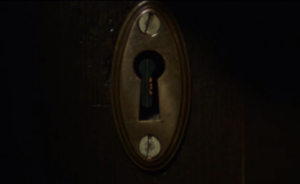
Meanwhile, this week’s ‘B’ plot comes to you from the other side of this keyhole.
Nothing much to say just yet. The peaks and valleys seen in Essie’s luck are a great way of demonstrating the leprechaun’s volatile nature, and the historical mise en scene is beautifully recreated. I wouldn’t be surprised if a large chunk of the show’s budget went to this episode alone — not for the same fancy CGI that previous weeks have used so extensively, but for all of the costumes and sets they probably had to make to get these periods looking as good as they do.
*
Present Day
Back in the present, Laura, Sweeney, and Salim stop at a roadside attraction that features a giant statue of Tatanka Ska: a white buffalo that was born on the ranch some years before. Sadly, both it and the owner were killed by a lightning strike a year later. Sweeney remarks that this sort of thing is to be expected when you put a god in a petting zoo.
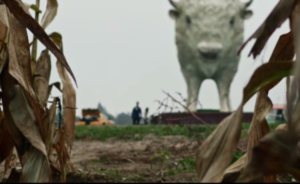
Such an interesting detail. So the buffalo was a god, but not, I think, because it was legitimately born one or because people actually ‘worshiped’ it in the way we think of when we hear the term. Rather, it simply took on the air of the supernatural thanks to superstition. Does this mean that otherwise mortal beings, animal or otherwise, can become deities if given enough of a mystique?
Salim lays out his rug to pray again. He offers to let Laura (who has accrued a lot of flies at this point) join, but she does not accept. She asks him if he loves — or is in love with — God. Salim is rather vague in reply, saying that he “loves his God.” I think it’s meant to be ambiguous, whether he’s referring to the jinn or not.
Sweeney goes off to pee, and gets cawed at by a raven in a tree. Sweeney tells the bird that he is headed to Wisconsin as Wednesday asked, and that he has held up his end of the bargain. The bird won’t shut up, however, so Sweeney tells it off.

Actually, Sweeney, you’re going to Kentucky. I don’t think Wednesday is going to buy that little lie of yours. You’d better hope you can get Laura her resurrection quickly.
Speaking of whom, Dead Wife corners him and tells him that they should let Salim go — they’re close enough to their destination that they don’t need him. Sweeney refuses, but ends up letting slip that after this detour, he’s headed to the House on the Rock in Wisconsin. Laura promptly tells Salim, who takes the hint and drives off.
Aw, man. I was hoping this would last longer. And Salim basically fleeing (he leaves his prayer rug behind, for goodness’ sake) seems sort of weird. It’s not as though he was actively being held hostage, and I thought that he was sort of bonding with Laura. Eh, whatever. I suppose the arrangement had a prompt expiration date from the start, since the gang should be reaching Wisconsin next week anyway, but I’m still kind of bummed. I suppose all three of them will be heading off for who-knows-where after the whole thing blows over, though — if we’re following the book here, it isn’t exactly going to end well to begin with, but the preview for the finale makes it look like it’s going to be even more explosive — so perhaps season two will give us more.

Laura marches over to an ice cream truck, tells the driver that he’s being robbed, and makes Sweeney give him some money as compensation. The driver, who seems very down with this plan, asks Laura to punch him to make the exchange more believable. Sweeney gives him a hit instead, since Laura would probably kill him.
Ah, these flashes of quirky humor give me such a kick. The whole scene also makes me think of Fuller’s Pushing Daisies: a bit of black humor, some pastels in the sets (it is an ice cream truck, after all), and novelty food.
Ibis starts to write again as Jackal sets out another drink for him. I’d say there’s a 96% that they’re a couple, and I am all about that.
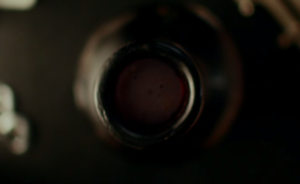
This week comes to you from the inside of an alcoholic beverage, also. Weird scene transitions.
*
17XX
Essie has stopped viewing theft as a crime, so she makes the most of it as she continues to stay in London. At a market, she swipes lace, bows, and more. It isn’t honorable work, admittedly, but it gives her autonomy. She believes that her success comes from the creatures of her homeland, so she continues to make offerings. At night, her window opens as somebody reaches down to pick up the milk she’s left.

Her life is going well, but her fortunes lead her to forget her gifts. Eventually, she gets caught. Charged both for theft and her escaping the terms of her transportation deal, she’s thrown into jail, where she will wait until she’s taken to the gallows.
Her cellmate, as it turns out, is one Sweeney, who’s in for an accidental eye stabbing. They commiserate, and Ellie leaves bread at the window.
He asks after America, which Laura never really got to see, then suggests she bribe the warden. He wishes he could give her some of his gold to do so, but he’s given it to the King. (Which begs more details on Sweeney’s ‘stash.’ Where does he keep his gold? How much does he have? Is this the same king that he’s now in trouble with? Why is he constantly giving it to other figures? Does he run some kind of bank?)

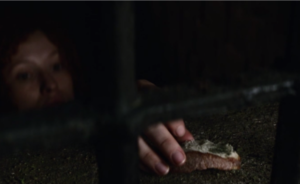
Essie admits that she wouldn’t mind seeing America, because it’s a place where one can start over. She knows that she’d be happy with nothing more than a home, a tree, and somebody to do right by her. Sweeney wonders what he would do there, and she suggests delivering gold to their king. He points out that they don’t have one, but Essie seems sure that they will one day (foreshadowing!). “Everyone needs their king,” she claims. The next morning, she finds him gone from his cell, and the bread gone from her window.
I missed a lot of the important stuff in this conversation until I watched it a second time. It all ties really nicely into the ending of the hour (which we’ll get to), but I’m curious what her suggestion is meant to convey, since it obviously comes true years later. Did Sweeney take her idea to heart and convince somebody to become a king in America? What kind of deal do they have? Who is this royalty, anyway? There are a few crucial details to this subplot that need explaining.
I also appreciate how Sweeney is portrayed here. If nothing else, I give this episode credit for making me like him, which I didn’t really want it to do. He’s still an ass, of course, but we get to see a kinder side to him, and that’s a start. The fact that Essie is being played by Laura’s actress makes me worry, though, since it heightens my suspicion that they’re going to try to pull some kind of romance out of Mrs. Moon and the leprechaun.
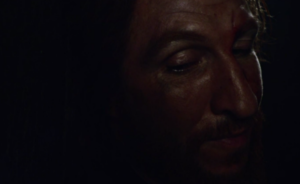
Why does he look like Matthew McConaughey?
The warden him comes to Essie’s cell with a meal, and is generally a very creepy fellow. He tells her that it will be several months before her case is heard, that she’s very pretty, and that there might be a way to get out her mess. She takes his offer.

Months later, she shows up to her hearing pregnant. Her sentence is once again transportation, and she is sent to Virginia, where her indenture is bought by a tobacco farmer named John Richardson (Peter Cockett), whose wife has recently died. She becomes his wet nurse and maid.
With her child and his side by side, she tells both the old tales of her homeland.
*
Present Day
Driving along in the ice cream truck, Sweeney complains about the cold, which Laura ignores. Along the side of the road, a rabbit watches them pass. Okay, weird. Strange animals are to be expected in this series, though, so we’ll come back to that.
Laura wonders if his resurrectionist will truly be able to bring her back to life, but Sweeney assures her that he will — for a favor, though, not gold. Sweeney mentions his ‘horde’ and states that he was once a king, but time has robbed him of that distinction. Thanks to religion and consumerism, his people have become fairy tales and pop culture jokes. (And apparently a bird? Why was he a bird?)
Laura asks what Wednesday hopes from his meeting, and Sweeney says that it’s war. He once was meant to go to war, but, on the eve of battle, he looked into the fire and saw his death. Frightened, he fled (‘flew’, apparently), and now he believes he owes a battle. Laura wonders why he’s willing to run errands for Wednesday, but he says that he’s had to do worse.

Yeah, I wouldn’t want to see this in my fire, either.
Interesting. It’s good to see modern Sweeney with a softer side as well, and I’m interested in the details here. Perhaps Wednesday transformed him to allow him to escape his first war, and that’s why Sweeney owes him his loyalty? Despite not being the focus of the episode, I think the script does a great job with the few scenes it gives him to really add some nice depth to the character beyond ‘potty-mouthed drunk.’
Out into the road runs another (or the same?) rabbit, which causes Laura to jerk the wheel and send the truck flipping. In the crash, Laura goes through the window, and doing so rips open her chest and causes her coin to go flying. She lands on the road, once again permanently dead.
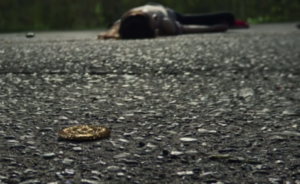
Huh. Well, a few things about this.
One: beautifully shot sequence. More gratuitous slow motion and a sort-of-inappropriate-but-it-still-works-somehow jazzy soundtrack, and the whole thing is so unexpected that you have to take a minute to understand what’s happening. I really dig Laura’s bemused look as she’s being flipped upside down, as if she’s thinking “well, great.”
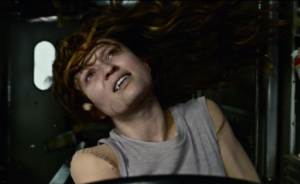
“This is definitely a minor inconvenience.”
Two: interesting twist by having Laura actually lose her coin. I almost find it hard to believe, but I suppose somebody who is technically a rotting corpse being flung through a windshield at high speed is bound to tear some stitching. Lucky for her that she didn’t have her face bashed in or something, too, since that wouldn’t have been quite so easy for Ibis and Jackal to fix up. I’m assuming at this point that Sweeney is able to heal very quickly, since he’s been just fine since Laura beat him up a few episodes ago, and he somehow manages to survive this. Confirming that Dead Wife is infallible is a nice way to contrast the Superman-esque vibe she’s had since she came back, too.
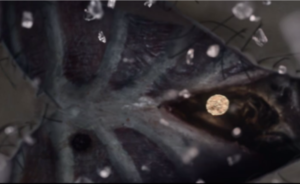
Three: so, I’m assuming the rabbits come from Easter, who I know will be showing up in the finale next week. (Finally. I’ve been waiting for Kristin Chenoweth all season.) If that’s the case, though, why did she try to kill these two? Is she working with the New Gods? Did they give her instructions to take out Wednesday’s helper? I hope that isn’t the case, since she’s pretty clearly on Shadow’s side in the book despite her initial reluctance to get involved. And I feel like I should have thought of this before, but: Is she the one Sweeney is hoping can resurrect Laura? Being the goddess of spring and new growth, I feel like it’s possible, but he’s never specified that his contact is a woman, so I’m not sure.
*
17XX
Back to Essie. The children are older now, and she tells them of Samhain, leprechauns, and the necessity of leaving out part of one’s harvest — she puts an apple on the porch. Richardson one night makes an advance at her, but Essie acts shocked at the move, saying that she can’t possibly return the feelings to a man whom she’s indentured to. He, in response, proposes marriage, and she accepts.
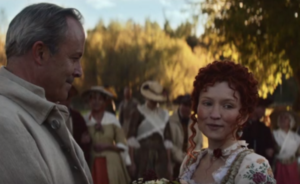
Richardson turns out to be a kind man, and the two are fairly happy together for a decade before he passes from fever. In his place, Essie takes over the running of the farm, which prospers. She continues to leave offerings out in the field for the fae folk.
I can’t tell if Essie is supposed to genuinely like Richardson or not. This is where the parallel between her and Laura is most clear, I think: they both take advantage of the men around them to further their own goals. The problem, however, is that this comparison isn’t a good one once you look past the basic concept. Essie does this in order to survive in a hard world in which she has very little, and so it’s almost necessary. Laura does this in order to fill an emotional emptiness — which is certainly an issue, but nothing life-threatening. Otherwise, she has a fairly nice life (before she died, anyway).
I’m not sure, then, how we’re meant to understand the relationship that Essie finally settles in with Richardson. She’s obviously taking advantage of his feelings to escape her indenture, but it’s unclear if she ever learns to care for him or not. And if she does, how much of that feeling is authentic? Using Laura as a mirror muddies it even more, I think, because I can’t tell who is meant to act as the point of reference to the other. Is it that Essie, like Laura, needs these relationships to gain something that she’s never truly able to have, and so it’s all a front? Or is it that Laura, like Essie, will eventually learn to love truly once she realizes what she needs and most wants?
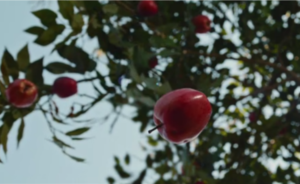
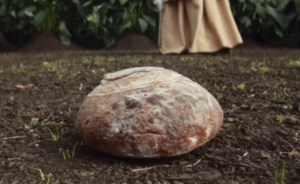
Perhaps it’s not meant to be clear. If that’s the case, I tip my hat to the writers for the complexity. If it isn’t, though, I’ll say again that using Browning the way they did fudged the concept a bit.
For my part, I’m going to go with the latter, simply because that seems the more optimistic route, and the fact that it really ties this part of Essie’s life to her earlier conversation with Sweeney nicely: she asked for a home, a tree, and a man who does right by her, and that’s exactly what she ends up getting.
Years pass, and the farm continues to flourish as Essie grows older and her children have kids of their own. In another weird casting move, she’s now being played by the same actress (Fionnula Flanagan?) who played her own grandmother at the start of the episode. I suppose it’s understandable, since they are related and all, but it’s still kind of bizarre.
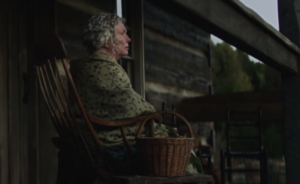
She’s returned! May she never die.
Eventually, she stops telling her stories. Her grandchildren are frightened off by the tales, and nobody is interested in the old ways. She continues to believe in them, however. One night, a certain leprechaun shows up at her porch, returning to that scene from the start of the hour.
*
Present Day
Sweeney wakes up in the ice cream truck, more or less fine. (Again, I assume that he just heals fast.) He finds Laura properly dead again, and his coin in the road. He grabs it and starts to walk off, but stops. He remembers another crash he walked into recently — Laura on the side of the road, dying for the first time. He saw a raven in a tree, and told it to “tell him it’s done.”
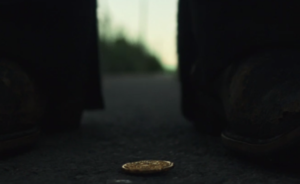
Well, that’s interesting. I don’t think the book stated that Sweeney was involved in the crash that killed Mrs. Moon and Robbie, but Wednesday was most certainly implicated, so it’s a natural extension. I’m sort of surprised we’re pulling this reveal — that Wednesday is responsible for Laura’s death — so early in the plot, as it’s something that doesn’t come up until the very end of the novel, but I think it’s understandable. Given the use of ravens during “Git Gone,” it was pretty obvious that the con man played a part, so stretching out a confirmation for another couple of years would have been fairly pointless.
I think it’s a good idea, actually, because now that the audience knows but the primary characters don’t, there’s a potential for new dramatic stakes. Will Sweeney tell Laura? If so, will she tell Shadow? What will Wednesday do to keep the truth from him? Rather than keep it as a last-minute twist, making the connection now gives the writers a tantalizing cliffhanger to pull out and explore whenever they may want to.

A guilty-looking Sweeney returns to Laura and yells a lot of Gaelic at the sky in anger. From what I’ve found poking about online, the translation appears to be: “Haven’t I believed enough in your bullshit? Haven’t I suffered enough? Isn’t that enough itself? I’m not evil! I’m not!” He stuffs Laura’s coin back into her chest, which melts through her bones. Laura comes back and promptly punches Sweeney in the face.
Clearly unphased, she marches over to the ice cream truck and effortlessly tips it back onto its wheels, then tells him to get in, hocking the horn in impatience.
I like this moment a lot. Again, it shows how the script uses smaller moments to really dig into Sweeney’s character. Having him decide to give Laura her life back despite having no actual demand to do so is a hugely defining moment for him and immediately makes me see him much more sympathetically — especially after the reveal of his part in her death. It also reinforces their rather nice chemistry together: him giving a half-smile and shrugging off her rudeness without calling her out or even telling her that he saved her is both funny and almost sweet.

Who knew these things were sturdy enough to just drive away from severe auto accidents?
I’m still not up for the idea of them becoming a couple, but after this, I might — might — entertain the idea.
Maybe.
Maybe.
Though if we’re following the book, it’s not going to last, anyway, so perhaps it’s best not to worry about it too much.
*
17XX
Let’s wrap things up with Essie. She knows that Sweeney is a leprechaun, and appears to remember him from years ago. He admits that America isn’t a great place for his folk, as nobody treats them properly. Neither of them has a quarrel with the other, but Sweeney does admit that it was Essie and a few others like her that brought him and his kind to the New World.
She thanks him for the good he’s brought her, and Sweeney reminds her that he’s given both good and bad. He offers her his hand, and she takes it. The next morning, her family finds her dead.
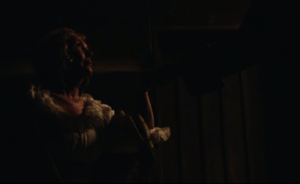
Never fear. She’ll return once her daughter gets old enough to require recasting.
Ibis finishes his story and closes his book. The camera returns to that initial shot of the English coast, the music swells, and I get weirdly emotional.
Some parting thoughts:
- I liked the use of ‘50s music throughout the episode. The context is fun (Ibis and Jackal playing it on their record player), and the asynchronous feel of it both in the past and present storylines is a nice way to tie them both together. It’s a bit much at times, but I wonder if that’s the goal at this point — when the show isn’t cranking out the really, really weird stuff, it tries to make up for it by cramming the more conventional plots with really over-the-top musical queues. Though I could really have done with the bit where the lyrics “daddy’s home” blare while Essie has sex with an older man. Yeesh.
- The production values are consistently gorgeous, which makes some of the props stand out when they aren’t quite up to the task of authenticity. Could they not find a more convincing wig for Browning to wear?
- Even if it is straight from the book, I feel like dedicating this whole episode to Essie’s story was something of a missed opportunity. Yes, she had a hard life, but using her narrative feels like the theme of the week tiptoes around the fact that there was, you know, actual slavery happening at the time. It may not be intentional, but it feels like the writers are ignoring that much, much worse plight to focus on a safer variant that they consider less demanding or controversial to portray. There’s an entire ‘Coming to America’ story in the novel that focuses on how black men and women put store in their religion while in captivity, so what gives? Was that short opening with Anansi from several weeks back meant to be their way of quickly speeding through the concept as fast as possible? Are we only willing to devote a bunch of time and money to one of these prologues if it deals with white people and their less uncomfortable circumstances? Come now. You could argue that it was necessary to do this one to better explain Sweeney and tie it into the present day story, but seeing as how he doesn’t exactly play a huge role despite the title, I’m going to say that that isn’t an entirely convincing case. It makes me wonder what the lesser of two evils would be: taking the safer route and ignoring an important story entirely, or tackling the more vital one but doing a messy and potentially offensive job with it? The best solution, of course, would to bring black writers onto the show to tell these stories, rather than letting white scriptwriters try to do so, but there you have it.
- I’m calling it now: Bilquis was sort of wasted this year. If they were going to use her, they should have either kept her to her one (book-based) introduction in the pilot and left it at a single ‘Elsewhere in America’ short, or given her a recurring focus most weeks to tell a legitimate story with her. As it stands now, she only had her one extra, fairly pointless bit in the second episode, and that was it. What was the point? I seriously doubt she’s going to get much time (if any) in the finale, either, since there’s going to be so much to cover. It’s like they started on a plot and then forgot to go anywhere with it. Perhaps next season?
*
“A Prayer for Mad Sweeney” is a good episode, and I enjoyed it a lot. The ending hit me emotionally in a way that I wasn’t expecting at all, and everything from the visuals to the acting is top notch.
Its problem isn’t that of standalone merit, but of how the hour fits into the season as a whole. As the penultimate episode of the season, it feels out of place — like one that should have happened around the time of “Git Gone.” Given how short this first year is, I suppose they didn’t have a whole lot of wiggle room to cram all of these plotlines into, but still. The finale looks as though it might suffer from trying to fit far too many big things into a single outing (unless they decide to give the episode an extended running time), so I’m wondering if it wouldn’t have been better to filter some of its content into this one.
It’s funny, but the show’s pacing has sort of thrown my expectations for the rate of adapting the source material for a loop. It’s like it’s simultaneously going too slow (giving side characters whole episodes while the main arc grinds to a halt) and too fast (withholding certain characters like Easter and Nancy until the very last minute).

To be fair, I can see the sense in the approach. Since they wanted to save the meeting at the House on the Rock for the finale (which is a bit early if we’re only getting three of them, but I digress), which is a sensibly big moment to leave off on, the writers jammed all of the important plot points from the book into the first three episodes to get them out of the way. As a result, they’ve had the last four to do whatever they please, and I think they’ve handled that free time well by creating content that balances both retrospective and expansive concepts to really fill out the world. And I suppose the characters delays make sense, too — Nancy doesn’t originally show up until just before the meeting anyway, and Easter isn’t actually introduced until much later.
Still, it’s an odd grab bag. Let’s really take our time on certain underdeveloped aspects of Gaiman’s book and give them room to breathe, but limit others just as they originally were on paper. I’d argue that I’d be much more interested in giving additional time to these sidelined gods than I would to the more normal characters like Laura. Why not give Bilquis or Nancy or Easter their own backstory-centric episode? The gods are the most interesting part of the story, and while I get the desire to more fully develop the humans in the cast for the sake of better grounding the plot and giving the viewer a chance to relate to them, it’s something of a waste.

Ah, well. I’m looking forward to the finale regardless, since it promises to be show’s biggest bit of spectacle yet. Hopefully, they manage to tie Laura and Sweeney into it in such a way that it justifies this week’s placement as the lead-in. And, who knows? Perhaps Fuller and Green plan to shift gears next season and move the spotlight to some of these second-string players.
Regardless, it’s been a fun ride.
Rating
Too slow and too introspective to feel like proper groundwork for what’s shaping up to be a very busy season finale, “A Prayer for Mad Sweeney” nonetheless uses its quieter tone and unusual approach to its source material to provide some important details and beautiful moments, both visually and narratively.
B+


Carina Olsen
Twitter: CarinaOlsen
Lovely review Monteverdi, as always 🙂 Aw, I’m sorry this episode wasn’t all that awesome. But glad you still liked most of it 😀 And ohh, final episode will be awesome? So exciting. Hope you’ll love it lots 🙂
Carina Olsen recently posted…In My Mailbox #293